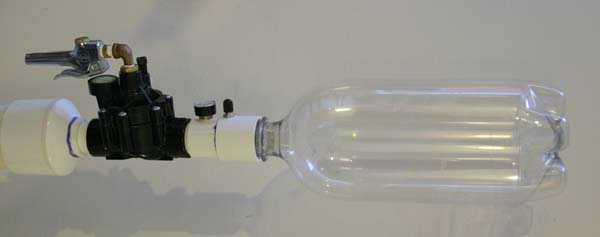Pneumatic Tennis Ball Launcher


Field Day 2003 was the testing ground for the third generation tennis ball launcher, dubbed "Trident". Two legs and the apex of a 400' vee beam were hoisted with three shots, a fourth shot was used to pull a messenger line over the beam to pull it loose from tree snags -- a 100% performance record on its first try out. The 5lb Trident also proved to be handy in the field, easily packed through waist high brush that would have been almost impossible for the previous model which weighed almost 22lb.
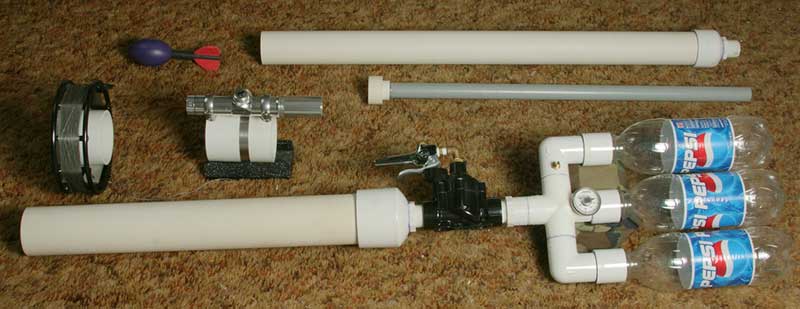
This picture shows the components of the Trident launcher. At the bottom is the launcher with 2.5" tennis ball barrel installed. Above it are the line reel, optical sight, and ram rod. Above them are the 2" barrel and Pocket Vortex projectile.
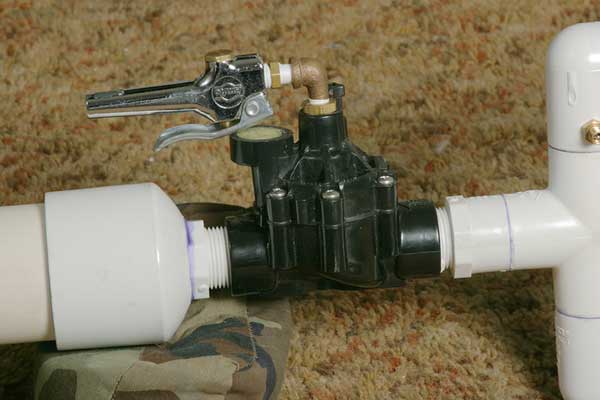
The valve used is a Rain Bird CPF-100 1" sprinkler valve with flow control. This is the same valve as was used in the second generation launcher, but only one valve is used. A glue-in valve could also be used, which will save some in overall length, but I went with the threaded type in order to change barrels and to break the launcher down for transportation. The solenoid was removed and its housing filled with epoxy to seal it. The flow control valve was removed and the housing was drilled out and tapped for 3/8" NPT and a 1/4" NPT reducer and elbow was installed to attach the Amflo blow gun trigger valve. Note that the trigger valve is arranged on the inside of the elbow so that it won't be as easy to bump and accidentally trigger the launcher.
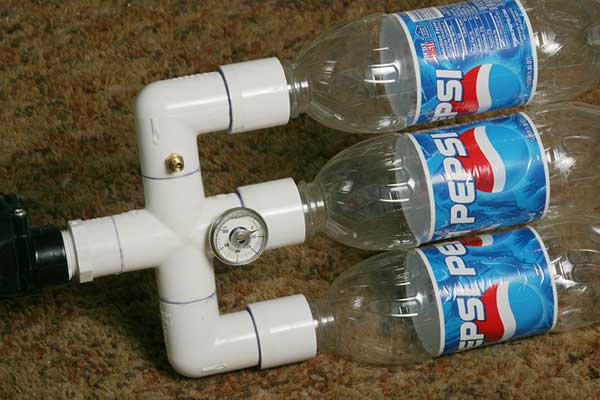
The pressure chamber consists of three 1-liter wide-mouth soft drink bottles connected through a cross joint and two 90 degree elbows, all of 1" PVC. The pressure gauge and fill valve were installed in 1/4" NPT tapped holes drilled in the fittings.
The soda bottles were chosen primarily for their light weight, but the choice is somewhat controversial. Although there are sources on the Internet that indicate the industry pressure-tests these containers up to 150psi, or that have destructively tested the bottles to 170psi, they are designed for holding pressurized liquids, and it is not guaranteed that they can hold pressurized air safely. The reader is cautioned that all responsibility for safety rests with him, and normal precautions (eye protection, protective clothing, etc.) should be used. I have personally tested the chamber above up to 90psi without any visible signs of stress, but I don't intend to use it above 60psi in the field. The tallest tree we shot this year (over 100ft) only required the use of 45psi pressure. Because of the double-thickness on all of the PVC fittings on the pressure side of the valve, I have few concerns about that part of the system.
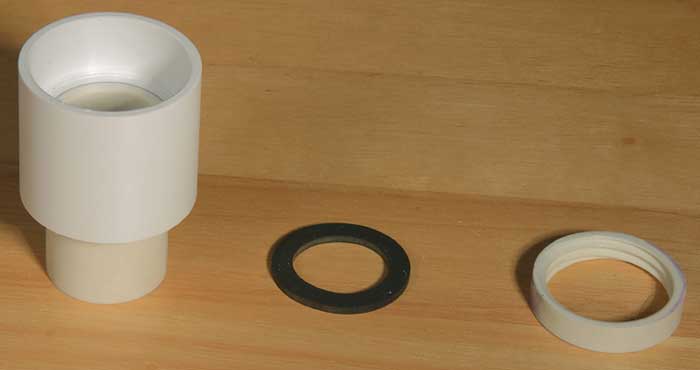
The bottle adapters were made from Lasco 1" to 1.5" slip/spigot PVC adapters. After a 2" length of 1" SCH 40 PVC is glued into one end of the adapter, the assembly was turned in the mini-lathe so that the inside diameter of the adapter just fits 1.25" PVC pipe, and the bottom of the opening (including the 1" pipe end) is turned flat. A piece of 1.25" SCH 40 pipe was internally threaded on the lathe at 8tpi, and rings of this material .36" wide were cut. The ring is then glued in the adapter assembly on top of a flat rubber washer, which provides the seal against the bottle's mouth. The final assembly looks like this:
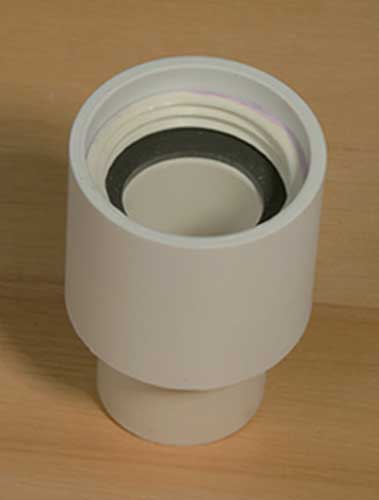
This glue joint must be done properly, with a good quality PVC primer and glue, and given sufficient time (a day or two) to set as it is holding a significant amount of pressure (both the pressurized air and the tension on the seal between the bottle and the washer) with relatively little surface area. The consequences of a failed joint could be a pop bottle launched at considerable velocity.
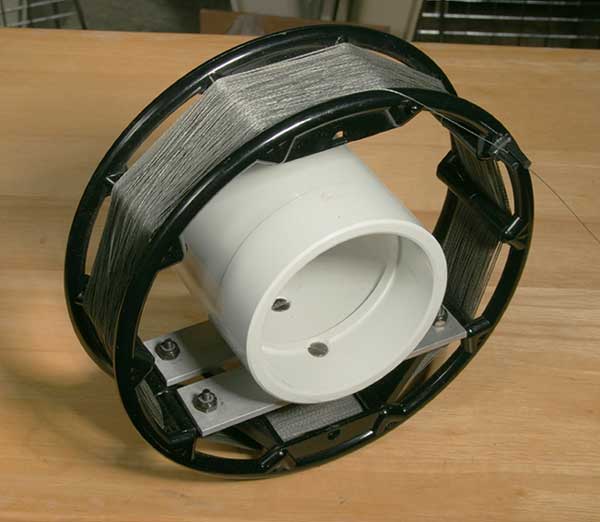
The reel is based on a Saunders Zip Reel bowfishing reel available here, among other places. This reel has some nice features for antenna launching relative to a fishing reel: it doesn't need line tension to hold the end, it releases the line cleanly, it puts very little drag on the line, it has a large line capacity (300 yards of line are on the reel in the picture above), and the coaxial mounting is rugged and insures the line won't hang up on anything as it unspools. The downside is that it's a bit more difficult to build, and rewinding the line is less efficient.
My preferred line is 50lb woven Spectra, such as the TUF-Line XP shown here. This type of line is light-weight, winds easily, doesn't try to tangle itself, and has a great stiffness that lets you feel the snags as you pull it back. Gloves should be used if you're going to pull hard on it, lest the strong, thin line cut your hands.
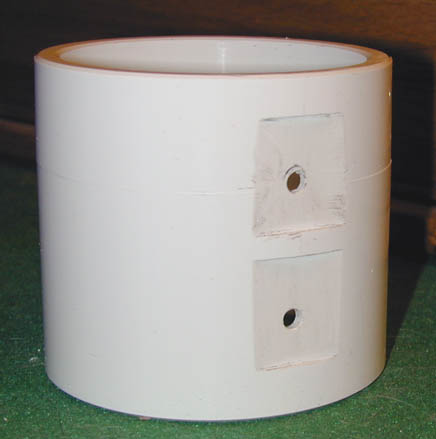
The reel is attached to a 2-1/2 inch PVC coupler sleeve. The sleeve is cut down a bit in length and milled with two inch-wide flats to accommodate the 1"x1/8" aluminum bar stock. The flats could also be cut by hand with a file, or epoxy could be used to build up the contact surface between the two -- the goal is to make a flat contact area between the two so that the forces generated by torquing the reel don't get concentrated at one point of the sleeve, possibly leading to failure of the plastic.
The hardware attaching the bars to the coupler is a pair of flat head machine screws, and a countersink is cut in the inside of the coupler for each screw head in order to recess it below the surface of the plastic. To cut the countersink, I drilled the hole for the threaded shaft, then inserted one of the screws from the inside and grabbed the shaft on the outside with a hand drill. Spinning the screw with the drill while pulling on it caused it to heat up enough to sink into the plastic and cut the countersink; you just have to be careful not to go too far and pull the screw through the collar entirely. A more controlled procedure would be to grind the screw head to expose a cutting edge, but so far I haven't hit on a shape that works to my satisfaction.
The coupler is simply friction mounted on the muzzle of the launcher, allowing it to be removed for reeling the line back in. This type of mount also works well for fishing reels if you prefer them.
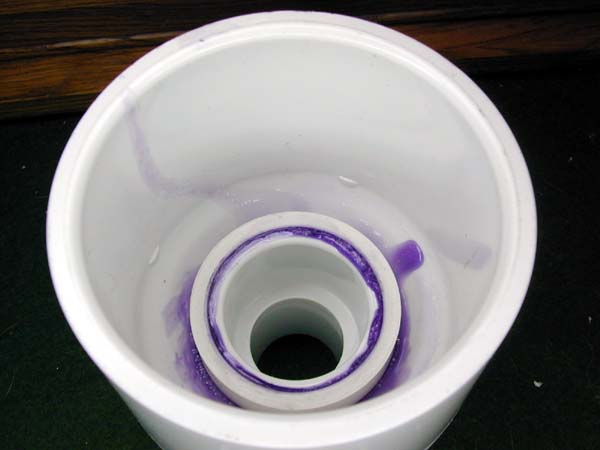
The barrel mount can be made with the standard set of reducers and couplers, but, since I was trying to make this as short and light as possible, I came up with this alternative. Starting with a 1" PVC slip/male threaded adapter, I turned the outside of the slip section so that it would just fit inside 1.5" SCH 40 pipe. Then I bored a hole in a 2.5" PVC end cap to just fit the OD of the turned adapter. A small length of 1.5" pipe was cut and the end turned so that the angle matched that of the inside of the cap. Then the fitting was glued in the cap, the pipe section glued over the end of the adapter inside the cap, and the whole thing was clamped together while the glue set.
The barrel itself is 2.5" SCH 40 PVC about 22" in length. This seems to work OK with the pressure chamber volume when weighted (4oz) tennis balls are used as projectiles. Just for fun, I made a second barrel using the above construction technique with 2" PVC pipe, this one 32" long. This size pipe perfectly fits a Pocket Vortex, a nerf-like throwing toy, if you cut down the vanes a little. This is a fun projectile for launching for maximum distance, my record is over 300 yards. Unfortunately, they're too light for pulling antenna lines, though we have hopes of modifying them in the future. The aerodynamic shape, greater directional stability, and more efficient smaller diameter barrels add up to great potential.
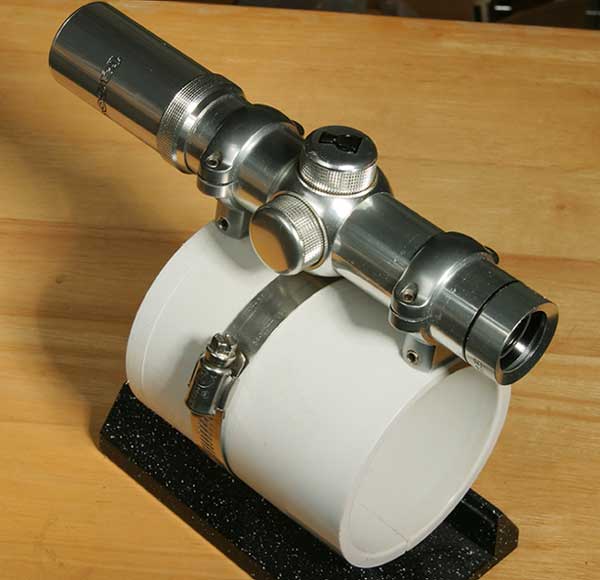
This is an optional part, the launcher can be instinctively aimed with sufficient accuracy without a sight. The scope I used is a Tasco Trophy 30mm 2X handgun scope with a dot reticle which gives sufficient eye relief when mounted at the end of the barrel. I'm told the scope rings are also from Tasco, but they do not appear to be in current production.. A 2.5" PVC coupler was machined for uniform ID and OD, and two flats were machined for a base of the rings. A counter-sunk hole in the center of each flat is drilled, through which pan-head pins pass which are gripped by the set screws in the base of the rings. The coupler was then split with a longitudinal cut so that it could be slipped onto the barrel and clamped in place with the hose clamp.
The reel has a circumfrence of about 21 inches. By firing straight
up
and counting how many turns of the reel it takes to wind back the line,
you can measure the height of the flight. Using a 5oz weighted
tennis
ball, the following heights were measured:
| Pressure (psi) | Turns | Feet |
| 15 | 23 | 40 |
| 20 | 41 | 72 |
| 25 | 57 | 100 |
| 30 | 68 | 119 |
| 35 | 75 | 131 |
| 40 | 93 | 163 |
| 45 | 97 | 170 |
